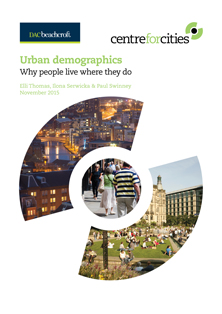01Introduction
Why do people live where they do? A complex set of decisions, trade-offs and priorities influence the decisions of individuals and families to locate in a certain place. Yet our understanding of how these often contradictory factors interact remains relatively limited.1 And the places where the 57 million inhabitants of England and Wales choose to locate has a huge impact on how we plan for the houses they live in, the transport they use, the shops, restaurants and facilities they visit, the jobs they work in and the public services they consume.
It is also a question that has received a significant amount of attention from commentators and policy makers over the years. Recently, most of the interest has related to city centres, and has focused on the significance of the location decisions of ‘millennials’, or the ‘creative classes’ – the highly educated, mobile generation born since 1980 that have increasingly turned their backs on suburban life in order to live in inner cities. Initially a US phenomenon,2 the debate has reached the UK in recent years, particularly in the context of urban renaissance and the return we have seen to city centre living over the last two decades.3
But the policies that have emerged from these debates – physical and cultural regeneration, for example – are based on a set of assumptions about why people live in certain places, when actually these choices are more complex, involving a range of physical, social, economic and environmental factors.4 And the focus on city centres has tended to view them as separate to the social and economic make-up of the cities and the wider hinterlands that they are a part of.
This report provides a new understanding of why people live where they do, at certain stages of their lives, across city regions. It builds on the findings from the first part of this research series, Urban Demographics: where people live and work, which looked at the characteristics of people living in the city centres, suburbs and wider rural hinterlands of 59 cities across England and Wales. The report demonstrated that while city centres are typically home to young, single, highly educated residents, suburban residents tend to be cohabiting or married with children, while hinterlands tend to be home to more over 55s and retirees.
These findings raised a series of questions around what has driven these trends. Why has there been a return to city centre living, driven by young, single, highly qualified people? Why do families choose to live in suburbs? Why do retirees tend to move into rural hinterlands? And why, when the demographic characteristics of suburbs and hinterlands look broadly similar across different cities, do city centres vary so much?
The report is divided into two main sections. Using polling data from YouGov across Great Britain and in four case study cities, as well as the demographic analysis undertaken for the first part of the research in 59 cities across England and Wales, the first part explains the reasons why people choose to live in certain parts of cities at certain stages in their life, and the second part looks at how this varies across cities, and why we see this variation. Finally, the report looks at the future implications of these trends and offers a series of conclusions and policy recommendations.
